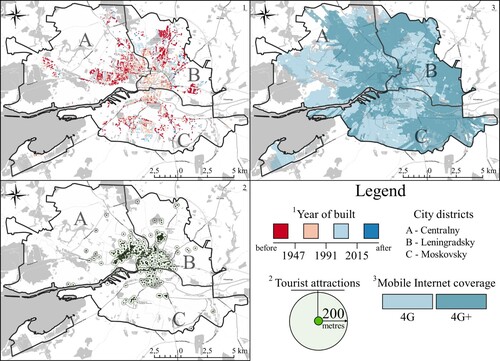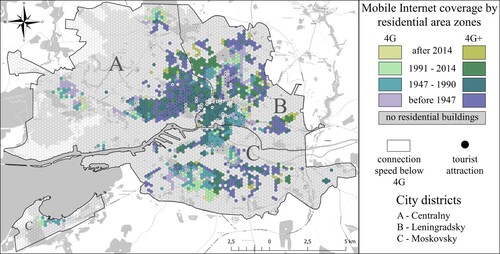ABSTRACT
Cities around the globe that have residential areas spanning several eras of architecture face the challenge of developing a comfortable urban environment. New urban spaces must accommodate the needs of a modern urban dweller constantly engaged with information and communication technologies and the Internet of Things. A viable urban development strategy is the smart-city model based on a digital city ecosystem using urban informatics technologies. The study case is Kaliningrad, a city with an over 760-year history of development. We present a comparative analysis of its housing development dynamics, tourist zones and mobile internet coverage in the residential areas. Our findings identify digitally advanced and peripheral inner-city areas and, using geoinformation data, showcase the development of digital urban space.
1. INTRODUCTION
Residential development in city districts reflects changing demands for urban spaces in different historical eras. Modern cities are undergoing a digital transformation – ubiquitous connectivity with high-speed Internet is becoming a basic need for residents, tourists, businesses and public institutions (Heaton & Parlikad, Citation2019; Panori et al., Citation2021). Studies on the revitalization of old urban spaces have urged the introduction of modern information and communication technologies (ICTs) in response to the new digital routines of city-dwellers (Mancebo, Citation2020; Oh, Citation2020).
Nowadays, as technological dependency is increasing worldwide, the digital divide is the principal split in society (Rogerson, Citation2020). Researchers have addressed new technology diffusion and adoption rates, indicating technology gaps within cities (Mills & Whitacre, Citation2003). Disparities in digital inclusion defined as access to information technology assets and the Internet (Sant’Ana et al., Citation2021) have been found across residential areas in advanced locations such as the city of San Jose in California – Silicon Valley’s hub (Levine, Citation2020). Although its entire territory is officially marked as ‘served’, the actual speed in some areas impedes performing certain online tasks. These disparities were accentuated by the Covid-19 outbreak when public entities and many businesses had to move online. As argued by Watson and Fox (Citation2021), persons with low internet speeds are disadvantaged and cannot be considered as having equal opportunities.
2. MATERIALS AND METHODS
The study uses geographical information system (GIS) and cartographic visualization to assess the readiness of urban spaces to embrace digital technology. We explore the relationship between housing development, the location of tourist attractions and mobile internet coverage as a critical component of a contemporary urban environment. This way, we correlate the dynamics of physical and digital urban dimensions.
The study uses data on Kaliningrad, the administrative centre of the Kaliningrad region of Russia. The city, established in 1255, is experiencing a migratory influx; it is expanding to accommodate new arrivals. In 2010–20, its population increased by 13.3%, reaching 489,359 people. Kaliningrad is divided into three districts: Centralny, Leningradsky and Moskovsky – with 135,360, 180,358 and 173,641 residents, respectively (). New micro-districts are emerging, and infill development is changing the appearance of the historic districts.
The data on mobile internet coverage are from Megafon, the telecommunications operator as of August 2021, focusing on the 4G+/LTE standard as compared with traditional wired connection speeds; the geodata on tourist attractions were obtained from the WikiVoyage database, the Regional List of Cultural Heritage Sites and the Prussia39 website; housing stock data are from the Dom.minzhkh online service and the regional government’s official website.
3. RESULTS
The city’s housing stock dates to four periods: pre-1947 – the Koenigsberg-era low-rise buildings; 1947–90 – Soviet-era (primarily) nine-storey buildings; 1991–2014 – the early Russian Federation period; post-2015 – modern multistorey residential complexes. Grids of 0.035 km2 hexagonal cells created using QGIS 3.16 reflect how three parameters combine: construction period, tourist attraction availability and mobile internet coverage ().
Although 4G is available in most of the residential areas in Kaliningrad, the average download speed is limited to 45.7 Mbps in many parts of the city. A high population density stimulates the spread of the latest Internet standards (a correlation of 0.986). There is also a direct positive correlation between the year of build and Internet coverage ().
Table 1. Distribution of paired correlation coefficients.
4. DISCUSSION
Smart-city technologies are in great demand in two types of areas: those dominated by modern residential complexes populated by avid internet users, and the traditional tourist areas with pre-1947 low-rise buildings. New residential areas have the highest 4G+/LTE penetration rate, similarly to the prestigious historic residential districts, home to half of Kaliningrad’s tourist attractions. Modern buildings bring a fresh vibe to familiar places – among other things, through an influx of new residents and businesses opening on the ground floors of residential buildings, whereas tourist districts have advanced ICT infrastructure even in areas with older housing.
Kaliningrad is in need of a ‘digital renovation’ of the remote periphery and micro-districts with multistorey Soviet-era buildings. Otherwise, these territories will face the dire prospect of digital marginalization. Apparently, the more actively digital technologies enter the daily life of the city dwellers, the more tangible their impact will be.
DISCLOSURE STATEMENT
No potential conflict of interest was reported by the authors.
Additional information
Funding
REFERENCES
- Heaton, J., & Parlikad, A. K. (2019). A conceptual framework for the alignment of infrastructure assets to citizen requirements within a Smart Cities framework. Cities, 90, 32–41. https://doi.org/10.1016/j.cities.2019.01.041
- Levine, L. (2020). Broadband adoption in urban and suburban California: Information-based outreach programs ineffective at closing the digital divide. Journal of Information, Communication and Ethics in Society, 18(3), 431–459. https://doi.org/10.1108/JICES-04-2020-0041
- Mancebo, F. (2020). Smart city strategies: Time to involve people. Comparing Amsterdam, Barcelona and Paris. Journal of Urbanism, 13(2), 133–152. https://doi.org/10.1080/17549175.2019.1649711
- Mills, B. F., & Whitacre, B. E. (2003). Understanding the non-metropolitan–metropolitan digital divide. Growth and Change, 34(2), 219–243. https://doi.org/10.1111/1468-2257.00215
- Oh, J. (2020). Smart city as a tool of citizen-oriented urban regeneration: Framework of preliminary evaluation and its application. Sustainability (Switzerland), 12(17), 6874. https://doi.org/10.3390/su12176874
- Panori, A., Kakderi, C., Komninos, N., Fellnhofer, K., Reid, A., & Mora, L. (2021). Smart systems of innovation for smart places: Challenges in deploying digital platforms for co-creation and data-intelligence. Land Use Policy, 111, 104631. https://doi.org/10.1016/j.landusepol.2020.104631
- Rogerson, S. (2020). The digital divide is a multi-dimensional complex. Journal of Information, Communication and Ethics in Society, 18(3), 321–321. https://doi.org/10.1108/JICES-05-2020-0060
- Sant’Ana, D. A., Pache, M. C. B., Borges, P. P., & Dias, J. L. E. (2021). Accessibility and digital inclusion in Brazil and South Korea: A comparison between micro and macro territorial approach. Sustainable Cities and Society, 64, 102524. https://doi.org/10.1016/j.scs.2020.102524
- Watson, A. H. A., & Fox, R. (2021). Digital divide: Mobile internet speeds in the pacific. Pacific Journalism Review, 27(1–2), 215–231. https://doi.org/10.24135/pjr.v27i1and2.1168


